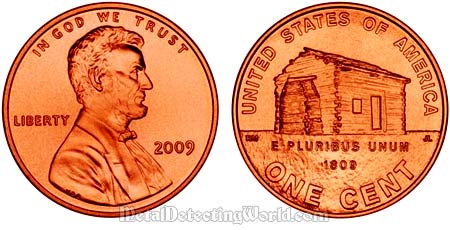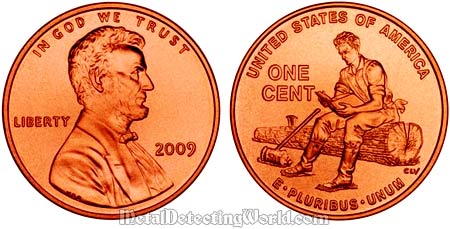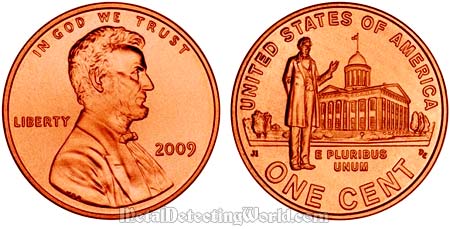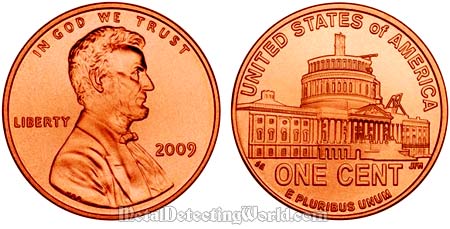Abraham Lincoln Bicentennial US One-Cent Coin (Penny) 2009
2009 Lincoln Bicentennial One Cent Program
On February 12, 2009, in recognition of the bicentennial of President Abraham Lincoln's birth and the 100th anniversary of the first issuance of the Lincoln cent, the US Mint presented the newly redesigned one-cent coin (penny) at the National Park Service's Abraham Lincoln Birthplace National Historic Site, in Hodgenville, Kentucky.
The new one-cent reverse designs were issued at approximately three-month intervals throughout 2009. In addition, the mint produced numismatic one-cent coins with the exact metallic content as contained in the 1909 one-cent coin (95% copper, 5% tin and zinc).
Like it had been for past 50 years, the obverse continues to bear the likeness of President Lincoln currently on the penny. The reverse reflects four different designs, each one representing a different aspect, or theme, of President Lincoln's life. The following images depict four designs of Abraham Lincoln Bicentennial small cent:
Design 1: Abraham Lincoln's birth and early childhood in Kentucky (1809-1816)
BRIEF HISTORICAL FACTS: Abraham Lincoln was born in a log cabin near Nolin Creek, three miles south of present-day Hodgenville in Hardin (now Larue) County, Kentucky, on February 12, 1809, the second child of Thomas and Nancy Hanks Lincoln. He was named after his paternal grandfather. The Lincoln family lived on 30 acres of the 228-acre Knob Creek Farm near Hodgenville from the time Abraham was two-and-a-half until he was nearly eight years old.
The reverse design features a log cabin that represents his humble beginnings in Kentucky.

Designer: The designer of this coin was US Mint AIP Master Designer Richard Masters. US Mint sculptor-engraver Jim Licaretz sculpted the coin following the Masters' design.
Design 2: Abraham Lincoln's Formative Years in Indiana (1816-1830)
BRIEF HISTORICAL FACTS: In the fall of 1816, Thomas and Nancy Lincoln left Kentucky for southern Indiana, settling in Spencer County. As he grew older, young Abraham became skilled at using a plow and, especially, an axe. Although the demands of frontier life left little time for formal schooling, his parents instilled in him a love for books and Abraham educated himself by reading such works as Life of Washington, The Autobiography of Benjamin Franklin, Robinson Crusoe and The Arabian Nights - all by the age of 11. He could often be seen carrying a book along with his axe.
The reverse design depicts a young Lincoln reading while taking a break from working as a rail splitter in Indiana.

Designer: US Mint sculptor-engraver Charles Vickers
Design 3: Abraham Lincoln's Professional Life in Illinois (1830-1861)
BRIEF HISTORICAL FACTS: In 1830, Thomas decided to move the family to Illinois, where he had relatives and where the soil was rich and productive. Early on, Abraham took a variety of jobs, including piloting a steamboat, but he was beginning to develop a serious interest in politics. In 1834, he was elected to the Illinois General Assembly, and began studying the law in earnest. In September 1836, he received a law license and embarked on the career that would propel him to the White House. In 1846 he won election to the U.S. House of Representatives as a member of the Whig Party.
The reverse design depicts Abraham Lincoln as a young professional standing in front of the state capitol building in Springfield.

Designers: US Mint AIP Master Designer Joel Iskowitz and US Mint Sculptor-Engraver Don Everhart
Design 4: Abraham Lincoln's Presidency in Washington, D.C. (1861-1865)
BRIEF HISTORICAL FACTS: At the 1860 Republican convention, Lincoln secured the nomination for President and was elected that fall. When Lincoln took office on March 4, 1861, the Nation was already on the verge of civil war, and fighting soon broke out at Fort Sumter, South Carolina. Shortly after the Battle of Antietam, in late 1862, Lincoln issued the Emancipation Proclamation, declaring all slaves in rebel territory free as of January 1, 1863. The Union victory at Gettysburg, Pennsylvania, on July 3, 1863, marked a crucial turning point in the war in favor of the North.
The war ended with General Robert E. Lee's surrender to General Ulysses S. Grant on April 9, 1865, at Appomattox Court House, Virginia. Five days later, on April 14, President Lincoln was mortally wounded by an assassin, John Wilkes Booth, while watching a play at Ford's Theatre in Washington. Army physicians worked to save his life throughout the night, but he never regained consciousness and died at 7:22 a.m. the next morning at the age of 56.
The reverse design features the half-finished United States Capitol dome, symbolizing a Nation torn apart by civil war and the resolve Lincoln showed as he guided the country through its most grave crisis.

Designers: US Mint AIP Master Designer Susan Gamble and US Mint Sculptor-Engraver Joseph Menna
Coin Specifics:
Diameter: 0.750 in., 19.05 mm
Thickness: 1.55 mm
Weight: 2.5 grams
Edge: Plain
Composition: Core is 99.2% zinc, 0.8% copper, with a plating of pure
copper; Total content is 97.5% zinc, 2.5% copper.
Mints: Philadelphia, Denver (mint mark D) and San Francisco (mint mark S)
Designer of Obverse: Victor D. Brenner
(Sources: www.usmint.gov)
Off the News Stand:
December 14, 2006
Because the prices of metals has gone up, the copper and zinc in modern 1-cent coin are worth 1.12 cents. So if 100 pennies are melted down, one can get a profit of 12 cents - and that has the government worried. U.S. Mint officials put into place rules prohibiting the melting down of 1-cent and 5-cent coins. The rules also limit the number of coins that can be shipped out of the country. "We are taking this action because the nation needs its coinage for commerce. We do not want to see our pennies and nickels melted down so a few individuals can take advantage of the American taxpayer," Mint Director Edmund Moy said in a statement. The new regulations prohibit the melting of 1-cent and 5-cent coins, with a penalty of up to five years in prison and a fine of up to $10,000 for people convicted of violating the rule.

Because of the prevailing prices of copper, zinc and nickel, the cost of producing pennies and nickels exceeds the face value of the coins. A nickel is 25 percent nickel and 75 percent copper. The metal in one coin costs 6.99 cents for each 5-cent coin. When the Mint's cost of producing the coins is added, the total cost for each nickel is 8.34 cents. Modern pennies have 2.5 percent copper content with zinc making up the rest of the coin. The current copper and zinc in a penny are worth 1.12 cents. The cost of production drives the cost of each penny up to 1.73 cents.
Pennies made before 1982, which are still in circulation, would be even more lucrative to melt down because they contain 95 percent copper and only 5 percent zinc. The metal value in those coins is 2.13 cents per coin, Mint officials said. The new regulations are being published in the Federal Register and will go into effect as interim rules which will not become final until the government has a chance to consider possible modifications based on public comments.
Make a Donation
Please help me stay afloat, afford more metal detecting trips with field-tests and experiments to create more informative articles, useful tutorials and helpful guides for detectorists, and maintain this website - the most informative hobby resource on the web! Since I do not have any steady income, any donation matters to me a lot! Thank you kindly!
Clicking on the donate button will take you to a donation page powered by Donorbox and dedicated to my website (MetalDetectingWorld.com). The donation page is PCI-compliant, secured by SSL/TLS, and has a simple form to fill out. Donorbox does not store any card or bank data. Credit card information is encrypted and tokenized by the Stripe payment processor.
This website would not exist without the advertisements we display and your kind donations. If you are unable to support us by viewing our advertisements, please consider making a Donation to ensure the future of this website. By helping me keep this website alive and growing, you will sure help many detectorists around the world as well!
ANNOUNCEMENT:
In January of 2020, I started a one-time fund-raising campaign in attempt to accumulate enough money to buy a simple but reliable 4x4 vehicle. My old 4x4 car (made in 1995) had faithfully served me for 10 years before it eventually went beyond repair last October. Without a 4WD, I will not be able to get to my hunt sites and test-plots hidden in the remote wooded areas inaccessible by a regular car.
Unlucky for me, those sites are the only locations available and suitable for my field-work which results in informative articles you can find on this website. For the past 10 years, my usual field-work has consisted of field-testing the latest metal detectors and accessories, experimenting with some of them, and devising new effective search methods that meet the requirements of the new metal detecting reality.
Before my car died, I managed to finish a couple of interesting detector-testing projects which will be covered in my upcoming articles. But other equally important projects that I was working on were not completed and had to be postponed until the Spring 2020. I hope that this fund-raising campaign will help me get a decent 4x4 by then so that I will be able to resume my work and to write more new articles, tutorials and guides based on data gathered through testing and experimentation.
If you find my website useful and would like it to provide more essential info for you and other detectorists worldwide, please consider chipping in $5, $20, $50 or whatever you can afford to keep MetalDetectingWorld.com growing in 2020. I promise you, it will be money well spent. Thank you.
Donate(Source: Martin Crutsinger, AP; Encyclopedia Of U.S. Coins by Mort Reed and The Official Red Book of United States Coins by R.S. Yeoman.)
- Please help me promote this guide:
If you would like to follow me on Twitter, please press a button:
I have my profile page on
where you can share your thoughts on this guide, ask me a question, or place a friend request.I also have my profile pages on Pinterest, LinkedIn, Tumblr, Reddit and Delicious
and my "Metal Detecting World" page on Twitter, Pinterest and Tumblr
I no longer maintain my old Facebook page